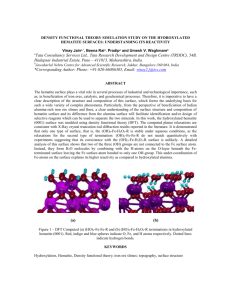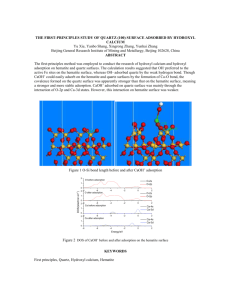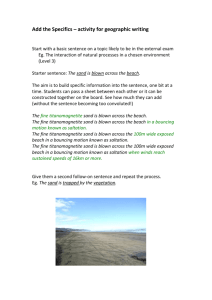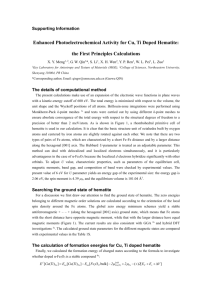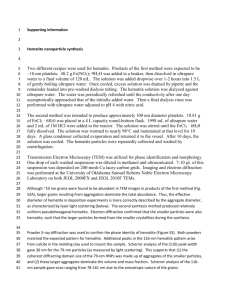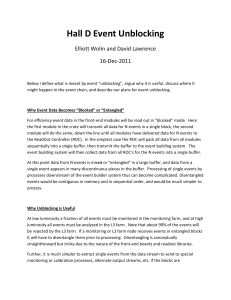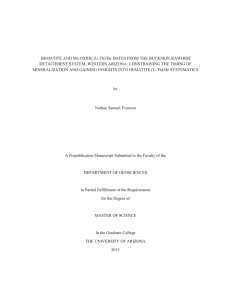jgrb50983-sup-0013-SupplementD
advertisement
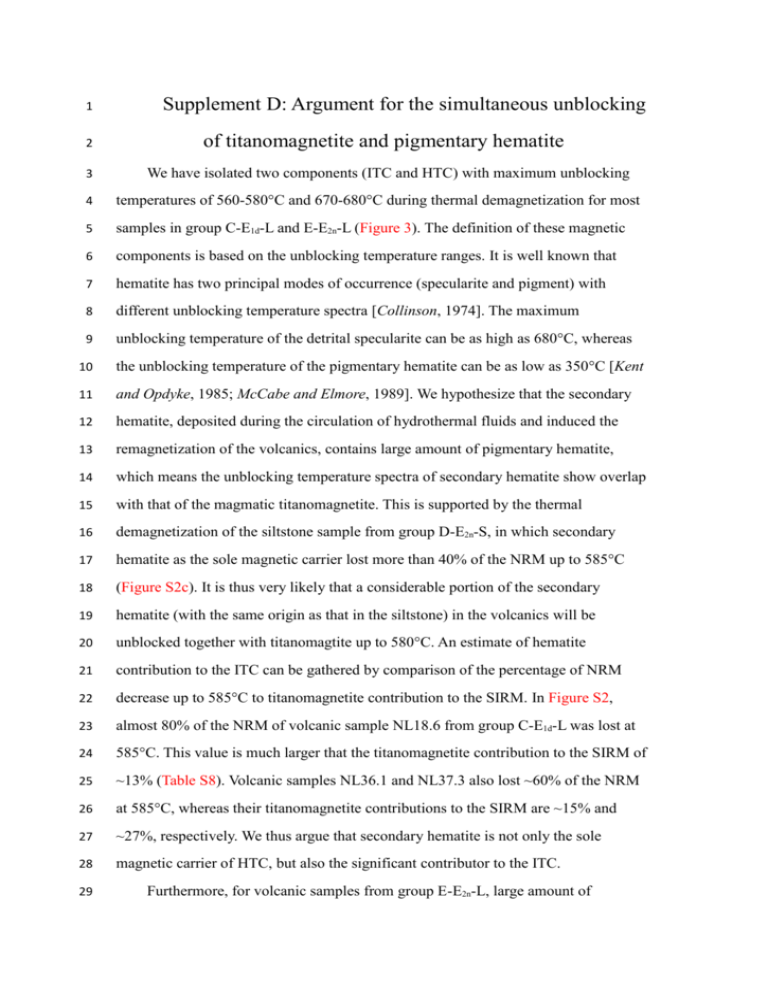
1 2 3 Supplement D: Argument for the simultaneous unblocking of titanomagnetite and pigmentary hematite We have isolated two components (ITC and HTC) with maximum unblocking 4 temperatures of 560-580°C and 670-680°C during thermal demagnetization for most 5 samples in group C-E1d-L and E-E2n-L (Figure 3). The definition of these magnetic 6 components is based on the unblocking temperature ranges. It is well known that 7 hematite has two principal modes of occurrence (specularite and pigment) with 8 different unblocking temperature spectra [Collinson, 1974]. The maximum 9 unblocking temperature of the detrital specularite can be as high as 680°C, whereas 10 the unblocking temperature of the pigmentary hematite can be as low as 350°C [Kent 11 and Opdyke, 1985; McCabe and Elmore, 1989]. We hypothesize that the secondary 12 hematite, deposited during the circulation of hydrothermal fluids and induced the 13 remagnetization of the volcanics, contains large amount of pigmentary hematite, 14 which means the unblocking temperature spectra of secondary hematite show overlap 15 with that of the magmatic titanomagnetite. This is supported by the thermal 16 demagnetization of the siltstone sample from group D-E2n-S, in which secondary 17 hematite as the sole magnetic carrier lost more than 40% of the NRM up to 585°C 18 (Figure S2c). It is thus very likely that a considerable portion of the secondary 19 hematite (with the same origin as that in the siltstone) in the volcanics will be 20 unblocked together with titanomagtite up to 580°C. An estimate of hematite 21 contribution to the ITC can be gathered by comparison of the percentage of NRM 22 decrease up to 585°C to titanomagnetite contribution to the SIRM. In Figure S2, 23 almost 80% of the NRM of volcanic sample NL18.6 from group C-E1d-L was lost at 24 585°C. This value is much larger that the titanomagnetite contribution to the SIRM of 25 ~13% (Table S8). Volcanic samples NL36.1 and NL37.3 also lost ~60% of the NRM 26 at 585°C, whereas their titanomagnetite contributions to the SIRM are ~15% and 27 ~27%, respectively. We thus argue that secondary hematite is not only the sole 28 magnetic carrier of HTC, but also the significant contributor to the ITC. 29 Furthermore, for volcanic samples from group E-E2n-L, large amount of 30 pigmentary hematite was also unblocked together with primary titanomagnetite 31 during AF demagnetization. In Figure S2e, almost 65% of the NRM of volcanic 32 sample NL37.3 was lost at 100 mT. This value is much larger that the titanomagnetite 33 contribution to the SIRM of ~28% (Table S8). AF demagnetization was usually 34 ineffective in isolating ChRM directions of volcanic samples from group C-E1d-L, 35 indicating that abundances of titanomagnetite and pigmentary hematite in these 36 samples are low. This is consistent with the SEM observations that secondary 37 hematite in volcanic samples from group E-E2n-L is usually much finer than that of the 38 volcanic samples from group C-E1d-L (Figure 7). 39 Therefore, we argue that it is impossible to discriminate TRM from CRM with 40 neither thermal demagnetization nor AF demagnetization because of the unblocking 41 temperature/field spectra overlap of magmatic titanomagnetite and secondary 42 hematite. 43 Simultaneous unblocking of titanomagnetite and pigmentary hematite could also 44 explain the similarity of ITC and HTC in direction. We infer that ITC is a mixture of 45 TRM and CRM, whereas HTC should represent CRM. The inclination difference 46 between TRM and CRM would be only ~20° (dip of the bedding)considering that no 47 significant tectonic shortening or N-S movement have ever happened on the Lhasa 48 terrane during the time interval of TRM and CRM acquisitions. Considering that 49 CRM contributes to both ITC and HTC and inclination difference of CRM and TRM 50 is not significant, it is therefore reasonable that the mean of the ITC directions and the 51 mean of the HTC directions are difficult to statistically distinguished; especially when 52 the noise induced by alteration of the magnetic minerals during laboratory heating is 53 also considered. 54 55 56 57 58 59 60 61 References Collinson, D. (1974), The role of pigment and specularite in the remanent magnetism of red sandstones, Geophysical Journal of the Royal Astronomical Society, 38(2), 253-264. Kent, D. V., and N. D. Opdyke (1985), Multicomponent magnetizations from the Mississippian Mauch Chunk Formation of the central Appalachians and their tectonic implications, Journal of Geophysical Research: Solid Earth, 90(B7), 5371-5383, doi: 5310.1029/JB5090iB5307p05371. McCabe, C., and R. D. Elmore (1989), The occurrence and origin of Late Paleozoic remagnetization in 62 63 64 65 the sedimentary rocks of North America, Reviews of Geophysics, 27(4), 471-494, doi: 410.1029/JB1094iB1008p10429.
